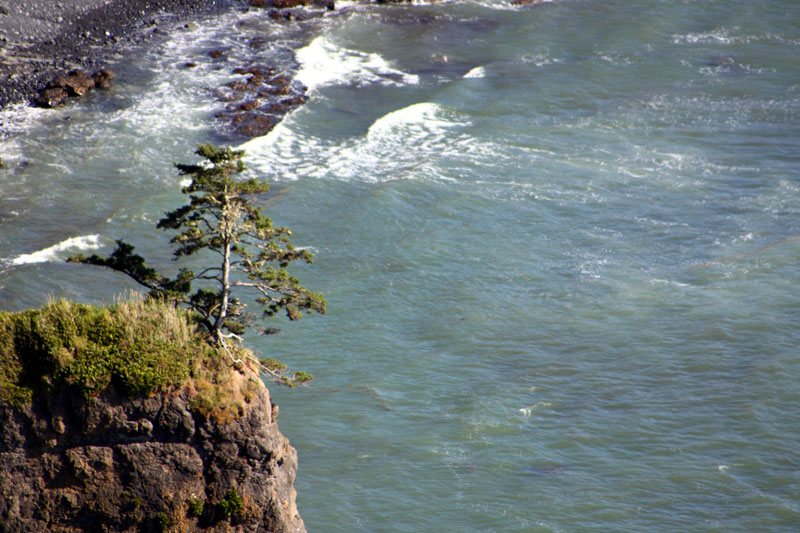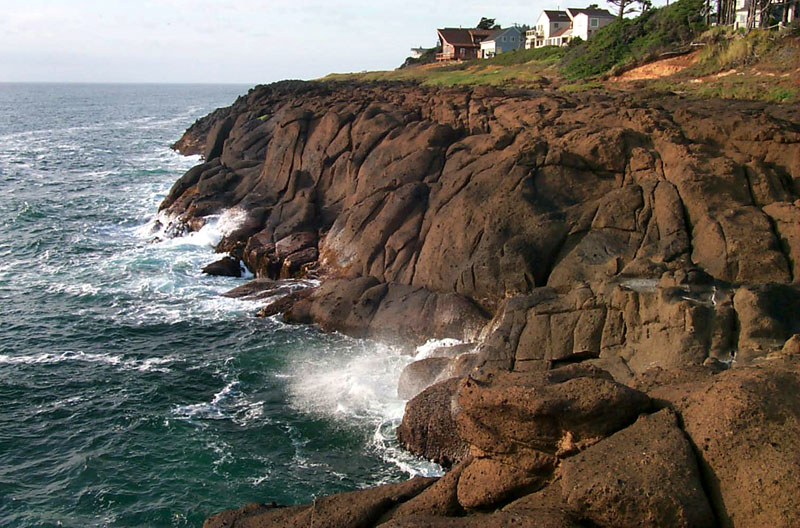Striking, Fiery Science of Depoe Bay and Newport: Oregon Coast Lava, Gray Whales, Dead Landmarks
Published 03/28/23 at 6:20 AM
By Oregon Coast Beach Connection staff

Includes exclusive listings; some specials in winter
In Cannon Beach:
Includes rentals not listed anywhere else
In Manzanita, Wheeler, Rockaway Beach:
Some specials for winter
In Pacific City, Oceanside:
Some specials for winter
In Lincoln City:
Some specials for winter
In Depoe Bay, Gleneden Beach:
Some specials for winter
In Newport:
Look for some specials
In Waldport
Some specials for winter
In Yachats, Florence
Some specials for winter
Southern Oregon Coast Hotels / Lodgings
Reedsport to Brookings, places to stay; winter deals
(Newport, Oregon) – There's always more than meets the eye along the Oregon coast. Wherever you look, there's an untold story, often ancient and maybe spooky (imagine 300 miles of lava flows). In the case of Depoe Bay and Newport, they're brother and sister in a funky, geologic way – and they both have their plot twists. That includes answering a big question about all those whales in the area and an older relative of an attraction in Nye Beach that just died. (All photos Oregon Coast Beach Connection)
Yaquina Head and Cape Foulweather NOT Volcanoes
Those were the theories at one point, but were debunked in the '70s. Newport's Yaquina Head and Cape Foulweather are both the product of the Columbia Basalts: a series of lava flows that scorched across proto-Oregon some 14 million years ago, coming from Eastern Oregon.

The shoreline was some 40 miles to the east then, and these areas were all under water. The lava flows came here and filled up gigantic underwater canyons, probably thousands of flows of millions of years. When they fill up spaces like this it's known as lava deltas, and eventually all the softer material around them eroded away, leaving these shapes. Those rocks, in turn, were eroded even more over the eons, turning into what we now see. Seaside's Tillamook Head and Manzanita's Neahkahnie Mountain were the same thing, among many others. Yaquina Head geology
What's All That Smooth, Rounded Rock at Depoe Bay?

Depoe Bay is basically basalt – that same black rock that's part of the Columbia Basalts. But why does it look smoother than other, similar spots?
According to Dr. Scott Burns, professor of geology at Portland State University, the area around Depoe Bay was, for whatever reason, above ground. He was actually one of the few scientists who's carbon-dated Depoe Bay's rocks.
So here, when the lava flows arrived they would hit the sea and cool into those rounder shapes. It's called pillow basalt, and it's the same thing you see footage of in Hawaii when lava plunges into water there.
These bubbly pillow basalts run from Fishing Rock State Recreation Area down to Rocky Creek State Scenic Viewpoint, roughly four miles on either side of Depoe Bay. You'll notice a big difference at the beginning of Otter Loop Road, at Rodea Point.
Ever wondered how deep those rocks go around Depoe Bay? According to Burns these layers can be hundreds of meters thick. Pillow Basalts of Depoe Bay
More Than One Jump-Off Joe in Newport

Old Jump-Off Joe, 1900 (photo courtesy Newport History Museum)
Most people are familiar with the famed Jump-Off Joe in Newport's Nye Beach, one of the closest things the coast has to a castle ruin-like structure (there's also that old bunker near Coos Bay).
Much of Newport is made of softer stuff than even the bedrock that sometimes shows at Moolack Beach. These soft, sandstone cliffs didn't take well to the change in currents when the jetties were built in the 1890s, and all of a sudden large outcroppings became shorter ones very quickly.

New Jump-Off Joe in 1925 - decades before the condos (photo courtesy Newport History Museum)
Then, one broke in half, and there was a giant blob at the tideline while the rest of the cliff dissipated. That blob was known as Jump-Off Joe – the original – and it was a hugely popular attraction through about 1916. The dino-looking rock acquired an arch, which tourists loved. In 1916, that arch fell apart, and then the rest was gone by the '30s.
Locals loved Jump-Off Joe so much they named a second headland immediately south of it as Jump-Off Joe. That, too, acquired an arch and became another huge hit through just about two years ago. In the '90s, that arch fell, and the rest of whittled away until it became absolutely unstable in early 2022. See the full story on both Joe's.
Resident Whales of Depoe Bay: Why?

Courtesy Oregon State Parks
Most people who are big fans or even beginner fans of whale watching on the Oregon coast know that Depoe Bay bills itself as the Whale Watching Capital, and with good reason. But what does that really mean?
There actually are more whales that hang out here than anywhere else. Of the 200,000 gray whales that wander up and down the west coast of both the Americas, some 200 stop and loiter at various spots.
According to Oregon Department of Fish and Wildlife’s Marine Mammal Program Leader Sheanna Steingass, PhD, in Depoe Bay there's approximately 75 gray whales that like to linger in the Depoe area, becoming what local experts call the “resident whales.” Over the last 30 years, she told Oregon Coast Beach Connection, that's about how many have been documented returning again and again. Some wander off and others come and replace them. There are also other random whales that visit along the way. This doesn't mean there's 75 hangin' out here all the time. The actual number can fluctuate wildly.
Many of them have been ID'd and even named catchy names, like the stalwart Scarback, whose old wounds make her stand out.
Why do gray whales linger at Depoe Bay? It's a great food source, Steingass said, with lots of mycid shrimp living in the kelp forests that are abundant here. In fact, there's a cute and endearing surprise here: Steingass said the knowledge of this place is passed on to their young. The babies acquire a “fondness” for this place, instilled by the mother. More Oregon Coast Whales
Hotels in Depoe Bay - Where to eat - Depoe Bay Maps and Virtual Tours
Hotels in Newport - Where to eat - Newport Maps and Virtual Tours
Cannon Beach Lodging
Nehalem Bay Lodgings
Manzanita Hotels, Lodging
Three Capes Lodging
Pacific City Hotels, Lodging
Lincoln City Lodging
Depoe Bay Lodging
Newport Lodging
Waldport Lodging
Yachats Lodging
Oregon Coast Vacation Rentals
Oregon Coast Lodging Specials
More About Oregon Coast hotels, lodging.....
More About Oregon Coast Restaurants, Dining.....
 Andre' GW Hagestedt is editor, owner and primary photographer / videographer of Oregon Coast Beach Connection, an online publication that sees over 1 million pageviews per month. He is also author of several books about the coast.
Andre' GW Hagestedt is editor, owner and primary photographer / videographer of Oregon Coast Beach Connection, an online publication that sees over 1 million pageviews per month. He is also author of several books about the coast.
LATEST Related Oregon Coast Articles
Happy ending for the elephant seal with tales from Oceanside to Long Beach. Marine sciences
Some Minor Traffic Impact This Month on Oregon Coast Range, Near Nehalem
Highway 26 at Humbug Creek and Miami Foley Road. Travel tips
Florence Rhododendron Festival Hits Florence and Central Oregon Coast Soon
May 15 to 18, food vendors, a carnival, parades and even a classic car cruise. Florence events, Newport events Manzanita events, Cannon Beach events, Seaside events, Astoria events
Whale Body Parts Found on Oregon Coast - Two Whales Strand on Washington Coast
One was a rare orca find; both suspected human interaction. Marine sciences
Goonies 40th Anniversary Bash on N. Oregon Coast Lets You Inside House, Immer...
June 5 - 8 in Astoria and a bit in Cannon Beach. Astoria events, Seaside events, Cannon Beach events
Daily Flights from Denver, Colorado to South Oregon Coast Begin This Week
United now flying to North Bend's Southwest Oregon Regional Airport. Coos Bay, travel tips
New Bus Routes to North Oregon Coast Begin in May
Running from Tillamook to Astoria, departing Beaverton, including wheelchair lifts. Rockaway Beach events, Tillamook events, Manzanita events, Cannon Beach events, Seaside events, Astoria events
Coos Bay in Summer 2025: Includes History Talk, Oregon Coast Music Festival, ...
Coos Museum Tuesday Talk June 3; Oregon Coast Music Festival Bandon to Coos Bay, July 12 to 26; North Bend July Jubilee July 18 - 20. South Coast events
Back to Oregon Coast
Contact Advertise on Oregon Coast Beach Connection
All Content, unless otherwise attributed, copyright Oregon Coast Beach Connection. Unauthorized use or publication is not permitted



















































